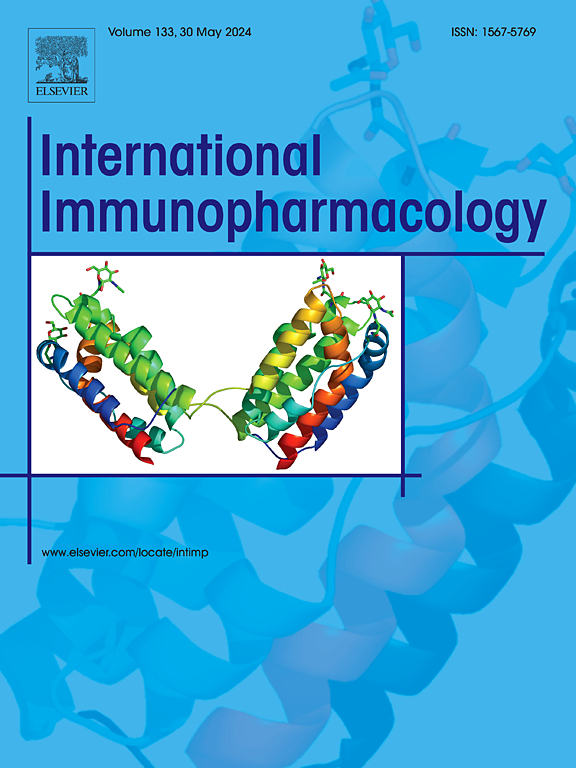Pathological roles of NETs-platelet synergy in thrombotic diseases: From molecular mechanisms to therapeutic targeting
IF 4.8
2区 医学
Q2 IMMUNOLOGY
引用次数: 0
Abstract
The formation of neutrophil extracellular traps (NETs) is a novel way for neutrophils to perform organismal protective functions essential for protecting the host against infections. Nevertheless, an increasing amount of data shows that uncontrolled or excessive formation of NETs in the body leads to inflammation and thrombosis. Many serious human diseases, such as sepsis, stroke, cancer, and autoimmune diseases, are associated with thrombosis, and inhibiting its formation is essential to prevent the development of many inflammatory and thrombotic diseases. With deeper research, it has been found that there is a complex interaction between NETs and platelets: platelets activate neutrophils to form NETs, while NET components enhance platelet aggregation and activation. This self-perpetuating vicious cycle between them mediates pathological processes such as inflammation, coagulation, and thrombosis. A deeper comprehension of the underlying molecular mechanisms between them promises to be a new target for thrombotic diseases. In this review, we concentrate on a summary of NET formation and its mechanisms of action. Providing a thorough summary of how neutrophils are activated by platelets to form NETs, how NETs cause platelet activation, and how this close interaction during inflammatory events affects the course of the disease, with the aim of providing fresh targets and ideas for thrombotic disease clinical prevention and therapy.
nets -血小板协同作用在血栓性疾病中的病理作用:从分子机制到治疗靶向
中性粒细胞胞外陷阱(NETs)的形成是中性粒细胞发挥机体保护功能的一种新途径,对保护宿主免受感染至关重要。然而,越来越多的数据表明,体内net的不受控制或过度形成会导致炎症和血栓形成。许多严重的人类疾病,如败血症、中风、癌症和自身免疫性疾病,都与血栓形成有关,抑制血栓形成对于预防许多炎症性和血栓性疾病的发展至关重要。随着研究的深入,我们发现NETs与血小板之间存在着复杂的相互作用:血小板激活中性粒细胞形成NETs,而NET组分则增强血小板的聚集和活化。它们之间这种自我延续的恶性循环介导了诸如炎症、凝血和血栓形成等病理过程。更深入地了解它们之间的潜在分子机制有望成为血栓性疾病的新靶点。在这篇综述中,我们集中在NET的形成及其作用机制的总结。全面总结中性粒细胞如何被血小板激活形成NETs, NETs如何引起血小板活化,以及炎症事件期间这种密切相互作用如何影响疾病的进程,旨在为血栓性疾病的临床预防和治疗提供新的靶点和思路。
本文章由计算机程序翻译,如有差异,请以英文原文为准。
求助全文
约1分钟内获得全文
求助全文
来源期刊
CiteScore
8.40
自引率
3.60%
发文量
935
审稿时长
53 days
期刊介绍:
International Immunopharmacology is the primary vehicle for the publication of original research papers pertinent to the overlapping areas of immunology, pharmacology, cytokine biology, immunotherapy, immunopathology and immunotoxicology. Review articles that encompass these subjects are also welcome.
The subject material appropriate for submission includes:
• Clinical studies employing immunotherapy of any type including the use of: bacterial and chemical agents; thymic hormones, interferon, lymphokines, etc., in transplantation and diseases such as cancer, immunodeficiency, chronic infection and allergic, inflammatory or autoimmune disorders.
• Studies on the mechanisms of action of these agents for specific parameters of immune competence as well as the overall clinical state.
• Pre-clinical animal studies and in vitro studies on mechanisms of action with immunopotentiators, immunomodulators, immunoadjuvants and other pharmacological agents active on cells participating in immune or allergic responses.
• Pharmacological compounds, microbial products and toxicological agents that affect the lymphoid system, and their mechanisms of action.
• Agents that activate genes or modify transcription and translation within the immune response.
• Substances activated, generated, or released through immunologic or related pathways that are pharmacologically active.
• Production, function and regulation of cytokines and their receptors.
• Classical pharmacological studies on the effects of chemokines and bioactive factors released during immunological reactions.

 求助内容:
求助内容: 应助结果提醒方式:
应助结果提醒方式:


